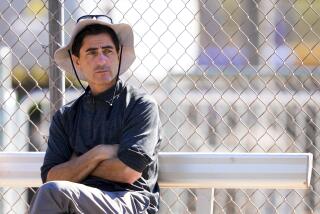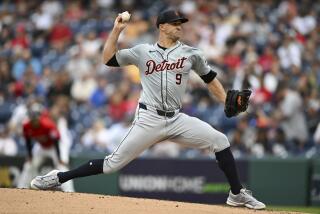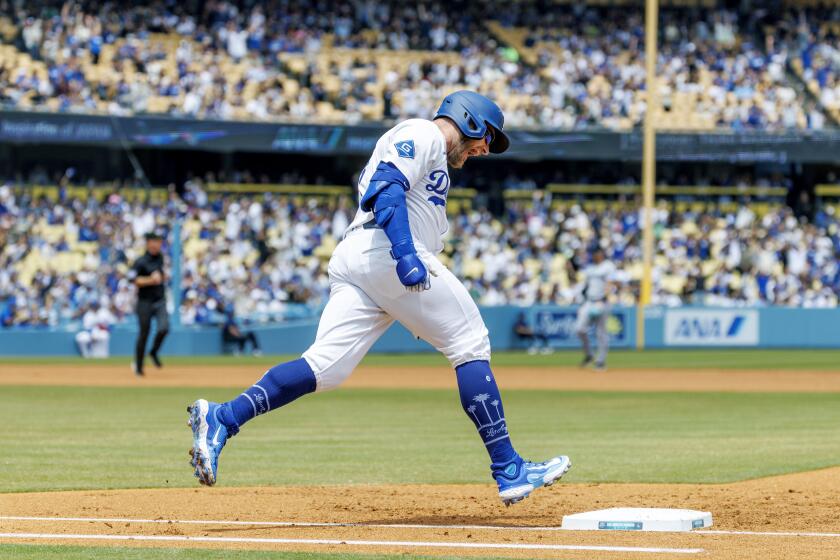Harris Throws Trade Label Out
- Share via
A “throw-in” in a baseball trade is kind of an afterthought. It ranks right along with “a player to be named,” a sop to the trading team to make its swap look better than it is. Kind of like a bank throwing in a toaster for a new account or an automobile dealer adding seat covers. A gesture, nothing more.
Lenny Harris was a throw-in on the deal that brought Kal Daniels from the Cincinnati Reds to the Dodgers. There is no evidence the Dodgers coveted Harris. The Dodgers needed some sock in the lineup at the time, and Daniels with his 26-homer and 94-RBI season seemed to be the answer.
When the Reds wanted pitcher Tim Leary and infielder Mariano Duncan for Daniels, the Dodgers wondered uncomfortably if they couldn’t throw in a toaster or a set of dishes. Something that would look good to the stockholders or, in this case, the O’Malley family.
So, the Reds threw in Lenny Harris.
The Dodgers figured Lenny was a warm body, but he had utility written all over him. He could--and did--play four infield positions. He could meet the ball with a glove or a bat. He didn’t strike out much, he could pinch-hit, pinch-run. He didn’t cost much, and if the trade didn’t pan out, they could always say, “Well, we expected more of Harris.”
There is no evidence they expected anything of Harris. But guess who is one of the leading hitters in the National League? Guess who ended up last season batting .304, stealing 15 bases, playing five positions? Guess who started the ninth-inning rally that overtook Chicago for the Dodgers Wednesday night? Guess who hit a grand slam against the Cubs in a recent road victory? And guess who is being touted for a write-in vote to make him the National League All-Star third baseman next month?
The throw-in is hard to throw out. On the field or out of the lineup. Although platooned with Jeff Hamilton early in the season, Harris won the job on a full-time basis and Lenny has gotten several of his key hits against left-handers, including the other night’s rally-starter.
What makes an overlooked player burst into stardom when traded? Usually, it is baseball’s well-documented myopia. He was not given a chance where he played.
Harris is not copping that plea. “When (Ron) Oester went down, I got my chance in the lineup in Cincinnati,” he says. Sometimes, it evolves around joining a heavier-hitting lineup. You get better pitches to hit batting in front of, or behind, a Ruth-Gehrig, Mathews-Aaron, Mays-McCovey middle-of-the-order. Harris may see more stuff to hit behind Darryl Strawberry, Eddie Murray and Daniels. But he hit behind Barry Larkin, Eric Davis and, yes, Kal Daniels in Cincinnati.
“I’ve always been a good hitter,” Harris explains. “I’m a better hitter when I’m comfortable and know exactly what is expected of me. Here, I do. I think everybody performs better under those conditions.”
A trade, he says, “sometimes sobers you up.” In his case, “I didn’t know why I was traded or even that I was being traded. Now, I think it’s wonderful, but at the time it can be frustrating.”
Trades have often come back to haunt baseball. In Harris’ case, one principal in his trade, Duncan, had an outstanding year, batting .306. The other, Leary, was traded to the New York Yankees, with whom he lost 19 games last year.
Only time evaluates trades. By common consent, the worst trade in baseball history--if you exclude Babe Ruth from the Boston Red Sox to the Yankees, which was a trade for money--was the Reds’ dealing of Frank Robinson to the Baltimore Orioles for a .500 pitcher, Milt Pappas, and two throw-ins. Baltimore was buying an annual pennant (virtual), and two World Series championships (actual). Cincinnati was getting a 12-11 pitcher. The second-worst trade may have been Lou Brock from the Cubs to the St. Louis Cardinals for a right-handed pitcher, Ernie Broglio. Brock went on to become the all-time base-stealing champion (until this season), and even though he had never stolen more than 24 bases as a Cub, he stole 118 one year as a Cardinal. He batted .348 his first year in St. Louis even though he had hit only .258 and .263 as a Cub.
It happens. A uniform change brings an attitude change--even a philosophy change. In Brock’s case, he went from the stand-around Cubs to the run-and-gun Cardinals, which suited him physically and psychologically.
Trades are supposed to help both clubs. They seldom do. What is more to be expected is, they will help neither club. Teams swap disappointments. Where trades do matter, one club is usually the clear winner. The Reds once got Joe Morgan, Dennis Menke, Cesar Geronimo, Jack Billingham and Ed Armbrister (and three pennants and two World Series championships) from the Houston Astros for Tommy Helms, Lee May and Jim Stewart. Multiple trades are risky. So are pitcher trades. The Yankees once got Allie Reynolds for an over-the-hill Joe Gordon--and an under-the-hill Eddie Bockman. The Orioles got Mike Cuellar (and four 20-game seasons) for Curt Blefary and John Mason. A trade is a crapshoot.
It is too early to tell if the Lenny Harris inclusion makes the top trade goof lists. But the Reds’ fans may some day want to know of the front office: “Who’s the wise guy who threw Lenny Harris into the Dodger deal?” Or the front office may ask one day: “Anybody remember who we got that time for Lenny Harris?” And the answer will come back: “Whatever, it wasn’t enough.”
More to Read
Are you a true-blue fan?
Get our Dodgers Dugout newsletter for insights, news and much more.
You may occasionally receive promotional content from the Los Angeles Times.










